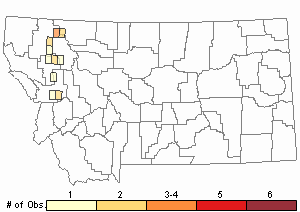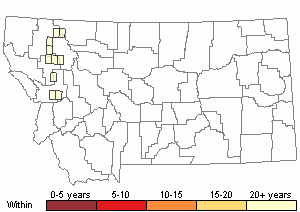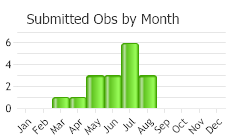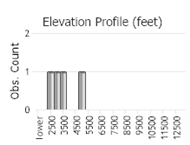View in other NatureServe Network Field Guides
NatureServe
Montana
Utah
Wyoming
Idaho
Wisconsin
British Columbia
South Carolina
Yukon
California
New York
A Heterocladium Moss - Heterocladium dimorphum
General Description
Plants: Pleurocarpous (Vitt 1988), growing in slender (Lawton 1971), open to crowded mats (Crum and Anderson et al. 1981), green with yellow tones, (Lawton 1971), dull (Smith 1980). Stems freely branching (Lawton 1971) to not precisely pinnate, creeping (Crum and Anderson et al. 1981); paraphyllia saw-toothed and frequently forked, few (Lawton 1971); superficial cells smooth (FNA 2014).
Stem Leaves: Overlapping (FNA 2014) and the leaf base upright or flat against the stem with the acumen loosely spreading when dry and spreading or recurved when damp (Crum and Anderson et al. 1981), occasionally reaching 1 mm in length (FNA 2014), 0.5-0.6 mm in width (Lawton 1971), cupped, egg-shaped (FNA 2014) to somewhat heart-shaped (Lawton 1971), the tip acute, acuminate (FNA 2014); base distinctly extending down the stem (Lawton 1971); leaf edges plane, saw-toothed to finely so from the base to the apex (Crum and Anderson et al. 1981); costa typically double, slightly less than half the leaf length, wide below (FNA 2014).
Branch Leaves: Not as large as the stem leaves, overlapping (Lawton 1971) when dry, spreading broadly when damp, more deeply colored and firmer than the stem leaves (Crum and Anderson et al. 1981), egg-shaped (FNA 2014) or widely so (Crum and Anderson et al. 1981); leaf tip acute or a little more widely-angled (Lawton 1971), generally more blunt than the tips of the stem leaves (Crum and Anderson et al. 1981), with an acumen; base only slightly extending down the stem (Lawton 1971); costa sometimes single or unclear (Crum and Anderson et al. 1981).
Leaf Cells: Laminal cells square to diamond-shaped (FNA 2014), with papillae on both ventral and dorsal surfaces (Lawton 1971) and one papilla (or prorula) at the far end of each cell; basal cells without papillae, those cells near the costa and extending to the leaf attachment distinctly elongate and larger than the nearly square cells near the margins; alar cells not distinct from the adjacent cells (FNA 2014).
Diagnostic Characteristics
Prorae of the upper laminal cells are easiest to see along the edges of the leaves (FNA 2014).
Heterocladium procurrens plants, with their very widely-spreading leaves, appear larger than plants of H. dimorphum. Their leaves are also glossy rather than dull, and their laminal cells are smooth rather than papillose (FNA 2014).
Range Comments
North American Range
AK, BC to CA, MT, WY, SD, ON to NL and NS, MI, NH and ME (FNA 2014). Known in Montana from Flathead, Glacier, Lake, and Missoula Counties (Elliott and Pipp 2016).
Observations in Montana Natural Heritage Program Database
Number of Observations: 17
(Click on the following maps and charts to see full sized version)
Map Help and Descriptions
Relative Density

Recency



 (Observations spanning multiple months or years are excluded from time charts)
(Observations spanning multiple months or years are excluded from time charts)
Habitat
Large stones or fissures in stone bluffs, sometimes on protected soil or humus of embankments along watercourses, bark of tree bottoms (Crum and Anderson et al. 1981). Occurring from lowlands to high altitudes (FNA 2014), reaching about 6560 feet (Lawton 1971).
Reproductive Characteristics
Dioicous. Seta 12-15 mm tall (Lawton 1971). Capsule level, bowed (FNA 2014), brown, 1-1.5 mm in length (Lawton 1971); peristome perfect, with somewhat long, knobby cilia (FNA 2014).
References
- Literature Cited AboveLegend:
 View Online Publication
View Online Publication Crum, H.A. and L.E. Anderson. 1981. Mosses of Eastern North America. 2 volumes. Columbia University Press, New York. 1328 pp.
Crum, H.A. and L.E. Anderson. 1981. Mosses of Eastern North America. 2 volumes. Columbia University Press, New York. 1328 pp. Elliott, J.C. and A.K. Pipp. 2018. A Checklist of Montana Mosses (1880-2018). Updated 3 January, 2020. Montana Natural Heritage Program, Helena, Montana. 73 pp.
Elliott, J.C. and A.K. Pipp. 2018. A Checklist of Montana Mosses (1880-2018). Updated 3 January, 2020. Montana Natural Heritage Program, Helena, Montana. 73 pp. Flora of North America Editorial Committee, eds. 2014. Flora of North America North of Mexico. Volume 28. Bryophytes: Mosses, Part 2. Oxford University Press, Inc., NY. xxi + 702 pp.
Flora of North America Editorial Committee, eds. 2014. Flora of North America North of Mexico. Volume 28. Bryophytes: Mosses, Part 2. Oxford University Press, Inc., NY. xxi + 702 pp. Lawton, E. 1971. Moss Flora of the Pacific Northwest. Hattori Botanical Laboratory. Japan: Yamabuki-cho, Shinjuku-ku, Tokyo. 362 pages plus appendices.
Lawton, E. 1971. Moss Flora of the Pacific Northwest. Hattori Botanical Laboratory. Japan: Yamabuki-cho, Shinjuku-ku, Tokyo. 362 pages plus appendices. Smith, A.J.E. 1980. The Moss Flora of Britain and Ireland. Cambridge University Press, Cambridge. 705 pp.
Smith, A.J.E. 1980. The Moss Flora of Britain and Ireland. Cambridge University Press, Cambridge. 705 pp. Vitt, D. J. Marsh, and R. Bovey. 1988. Mosses, Lichens & Ferns of Northwest North America. Seattle, WA: University of Washington Press. 296 p.
Vitt, D. J. Marsh, and R. Bovey. 1988. Mosses, Lichens & Ferns of Northwest North America. Seattle, WA: University of Washington Press. 296 p.
- Additional ReferencesLegend:
 View Online Publication
View Online Publication
Do you know of a citation we're missing? Elliot, J. C. 1993. Second checklist of Montana mosses. Unpublished report. U.S. Forest Service, Region 1. Missoula, MT. 45 pp.
Elliot, J. C. 1993. Second checklist of Montana mosses. Unpublished report. U.S. Forest Service, Region 1. Missoula, MT. 45 pp. Lawton, E. 1971. Keys for the Identification of the Mosses on the Pacific Northwest. Reprinted from 'Moss Flora of the Pacific Northwest'. Published as Supplement No. 2 of the Journal of the Hattori Botanical Laboratory. Nichinan, Miyazaki, Japan. 66 pp.
Lawton, E. 1971. Keys for the Identification of the Mosses on the Pacific Northwest. Reprinted from 'Moss Flora of the Pacific Northwest'. Published as Supplement No. 2 of the Journal of the Hattori Botanical Laboratory. Nichinan, Miyazaki, Japan. 66 pp.
- Web Search Engines for Articles on "A Heterocladium Moss"





